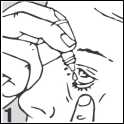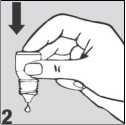Tobradex Eye Drops
Out of date information, search anotherRef: 0921/190315/1/F
Tobradex® Eye Drops
Patient Information Leaflet
Read all of this leaflet carefully before you start using this medicine because it contains important information for you.
* Keep this leaflet. You may need to read it again.
* If you have any further questions, ask your doctor or pharmacist.
* This medicine has been prescribed for you. Do not pass it on to others. It may harm them, even if their symptoms are the same as yours.
* If you get any side effects talk to your doctor or pharmacist. This includes any possible side effects not listed in this leaflet. See section 4.
Please note that the leaflet also contains information about other strengths of the medicine, Tobradex 3mg/ml and 1mg/ml.
In this leaflet:
^ What Tobradex is and what it is used for ^ What you need to know before you use Tobradex ^ How to use Tobradex ^ Possible side effects ^ How to store Tobradex ^ Contents of the pack and other information
^ What Tobradex is and what it is used for
Tobradex contains dexamethasone, a corticosteroid and tobramycin, an antibiotic which is active against a wide range of bacteria that may infect the eye.
It is used to prevent and treat inflammation and possible infection of the eye after cataract surgery in adults and children 2 years and older.
* If you use Tobradex for a long period of time, you may become more susceptible to eye infections, have increased pressure in your eye( s ) or develop cataracts.
You may still be able to use Tobradex, but discuss it with your doctor first.
* Intraocular pressure should be checked frequently, this is especially important in children below 6 years of age receiving dexamethasone-containing products.
* Do not give Tobradex to children below 2 years old because the safety and efficacy in this population has not been established.
Other medicines and Tobradex
Please tell your doctor or pharmacist if you are taking or have recently taken any other medicines, including medicines obtained without a prescription.
If you are using other eye drops or eye ointments, wait at least 5 minutes between using each one. Eye ointments should be administered last.
Pregnancy and breast-feeding
If you are pregnant or might get pregnant, or if you are breast-feeding a baby, talk to your doctor before you use Tobradex.
Driving and using machines
If you experience temporary blurred vision after using Tobradex you should not drive or operate machinery until your vision is clear.
Important information if you wear Contact Lenses
Contact lens wear is not recommended during treatment of an ocular infection or inflammation. Benzalkonium chloride, used as a preservative in Tobradex, may cause eye irritation and discolour soft contact lenses.
If you wear soft contact lenses remove them before using Tobradex and wait at least 15 minutes before putting them back in.

What you need to know Before you use Tobradex
Do not use Tobradex...
* If you have or think that you have any type of infection of the eye. Use of corticosteroids may make infections worse.
* If you have a sticky discharge from your eye.
* If you have a red eye that has not been seen by a doctor.
* If you are allergic to tobramycin or dexamethasone or to any of the other ingredients listed in section 6.
If any of these apply ask your doctor for advice.
Warnings and precautions
* If you have a disorder causing a thinning of the eye tissues, such as rheumatoid arthritis, Fuch's dystrophy or following a corneal transplant. Corticosteroids may cause further thinning and possible perforation.
* If you experience allergic reactions such as eyelid itching, swelling or, redness of the eye with Tobradex, discontinue use and consult your doctor. This allergic sensitivity may occur with other topical or systemic antibiotic of aminoglycoside type.
* If your symptoms get worse or suddenly return, please consult your doctor. You may become more susceptible to eye infections with the use
of this product.
* If you are using other antibiotic treatment, including oral, with Tobradex, ask your doctor for advice.
[3) How to use Tobradex
The usual dose
The usual dose is 1 drop in the affected eye(s) every 4 to 6 hours while you are awake. During the initial 48 hours, your doctor may increase the dose to 1 drop every 2 hours.
Do not use for more than 24 days.
Tobradex may be used in children 2 years of age and older at the same dose as in adults.
Remove the loose collar from the cap when the bottle is first opened.
Always use Tobradex exactly as your doctor has told you. You should check with your doctor or pharmacist if you are not sure.
How to use
* Wash your hands before you start.
* Shake the bottle well.
* Twist off the bottle cap.
* Hold the bottle pointing down, between your thumb and fingers.
* Tilt your head back.
* Pull down your lower eyelid with a finger, until there is a 'pocket' between the eyelid and your eye. The drop will go in here (picture 1).
* Bring the bottle tip close to the eye. Do this in front of a mirror if it helps.
Tobradex ®Eye Drops
Ref:0921 /190315/1 /B
Patient Information Leaflet (continued)

* Do not touch your eye or eyelid, surrounding areas or other surfaces with the dropper. It could infect the drops.
* Gently press on the base of the bottle to release one drop at a time (picture 2).
* Do not squeeze the bottle, only a gentle press on the bottom is needed.
* If you use drops in both eyes, repeat the steps for your other eye. Put the bottle cap firmly back on immediately after use.
* If a drop misses your eye, try again.
* If you forget to take Tobradex, do not worry, just take it as soon as possible. Do not take a double dose to make up.
* If you use more Tobradex than you should it can be washed out with warm water.
If you have any further questions on the use of Tobradex, ask your doctor or pharmacist.
Possible side effects
Like all medicines, Tobradex can cause side effects, although not everybody gets them.
The following side effects have been seen with Tobradex
Uncommon side effects
( may affect up to 1 in 100 people )
Effects in the eye: increased pressure in your eye ( s ), eyelid redness, eyelid swelling, eye irritation, eye pain, eye itching, watery eyes, eye discomfort.
General side effects: headache, runny nose, tightness of the throat.
Rare side effects
( may affect up to 1 in 1000 people )
Effects in the eye: redness, blurred vision, dry eye, eye allergy, eye surface inflammation.
General side effects: bad taste.
Not known ( frequency cannot be estimated from available data )
Effects in the eye: increase in pupil size, eyelid redness, increased tear production, eye surface inflammation.
General side effects: allergy ( hypersensitivity ), dizziness, nausea, abdominal discomfort, rash, swelling of the face, itching.
If Tobradex is used for more than 24 days, it may cause you to get an infection and the healing of your wound may also be delayed.
Reporting of side effects
If you get any side effects, talk to your doctor or pharmacist. This includes any possible side effects not listed in this leaflet. You can also report side effects directly via the national reporting system ( see details below ). By reporting side effects you can help provide more information on the safety of this medicine. United Kingdom Yellow Card Scheme Website : www.mhra.gov.uk / yellowcard
How to store Tobradex
* KEEP OUT OF THE SIGHT AND REACH OF CHILDREN.
* Do not store above 25°C. Do not refrigerate or freeze.
* Do not use after 4 weeks of opening the bottle.
* Do not use this medicine after the expiry date shown on the carton label or bottle label. If your doctor tells you to stop taking this medicine, return any unused medicine to your pharmacist (chemist) for safe disposal. Only keep this medicine, if your doctor tells you to. If your medicine becomes discoloured or shows any other signs of deterioration, consult your pharmacist (chemist) who will tell you what to do.
* Remember this medicine is for you. Only a doctor can prescribe it. Never give your medicine to other people. It may harm them, even if their symptoms are the same as yours.
* Medicines should not be disposed of via wastewater or household waste. Ask your pharmacist how to dispose of medicines no longer required. These measures will help to protect the environment.
* This leaflet does not tell you everything about your medicine. If you have any questions or are not sure about anything, ask your doctor or pharmacist (chemist). He/she will have additional information about this medicine and will be able to advise you.
[m Contnets of the pack and other information
Your medicine is called Tobradex Eye Drops but will be referred to as Tobradex throughout this leaflet. Tobradex is a clear eye drop solution, in a 5ml opaque plastic dropper bottle.
WHAT IS IN YOUR MEDICINE
Each ml contains 3mg of tobramycin and 1mg of dexamethasone as the active ingredients.
Inactive ingredients: disodium edetate, hydroxyethylcellulose, preservative: benzalkonium chloride (0.01%), purified water, sodium chloride, sodium sulphate, sulphuric acid and/or sodium hydroxide and tyloxapol.
WHO MANUFACTURED YOUR MEDICINE?
Tobradex is manufactured by Alcon Cusi, S.A., Camil Fabra 58,08320 EI Masnou, Barcelona, Spain and is procured from within the EU and repackaged by the Product Licence Holder: Lexon (UK) Limited, Unit 18, Oxleasow Road, East Moons Moat, Redditch, Worcestershire, B98 0RE.
If you have any questions or are not sure about anything, ask your doctor or pharmacist. They will have additional information about this medicine and will be able to advise you.
POM PL 15184/0921 Tobradex Eye drops Tobradex is a registered trademark of Novartis AG.
Revision date: 19/03/15
Blind or partially sighted?
Is this leaflet hard to see or read?
Phone Lexon (UK) Limited, Tel: 01527 505414 for help.